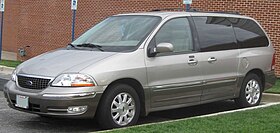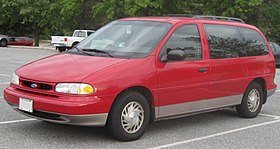Ford Windstar
| Ford Windstar | |
|---|---|
 |
|
| Overview | |
| Manufacturer | Ford |
| Also called | Mercury Monterey (see below) |
| Production | 1994–2004 as Ford Windstar 2004–2007 as Ford Freestar |
| Assembly | Oakville, Ontario, Canada (Oakville Assembly) |
| Body and chassis | |
| Class | Minivan |
| Layout | FF layout |
| Chronology | |
| Predecessor |
|
| Successor |
|
| First generation | |
|---|---|
 |
|
| Overview | |
| Production | January 27, 1994 – June 1998 |
| Designer | Camilo Pardo, Jack Telnack (1990) |
| Body and chassis | |
| Body style | 3-door minivan |
| Platform | Ford D186 platform (WIN88) |
| Related |
Ford Taurus Lincoln Continental Mercury Sable |
| Powertrain | |
| Engine | 3.0 L Vulcan V6 3.8 L Essex V6 |
| Transmission | 4-speed AXOD automatic |
| Dimensions | |
| Wheelbase | 120.7 in (3,066 mm) |
| Length | 201.2 in (5,110 mm) |
| Width | 1995–96: 75.4 in (1,915 mm) 1997–98: 75.8 in (1,925 mm) |
| Height | 1995–96: 68.0 in (1,727 mm) 1997–98 Cargo: 68.5 in (1,740 mm) 1997–98: 65.6 in (1,666 mm) |
| Curb weight | 3,800 lb (1,724 kg) |
| Second generation | |
|---|---|

Ford Windstar LX (1999–2000)
|
|
| Overview | |
| Production | July 1998–July 2003 |
| Designer | Moray Callum (1996) |
| Body and chassis | |
| Body style | 3-door minivan 4-door minivan |
| Platform | Ford V platform (WIN126) |
| Powertrain | |
| Engine | 3.0 L Vulcan V6 3.8 L Essex V6 |
| Transmission | 4-speed AX4S automatic 4-speed AX4N automatic |
| Dimensions | |
| Wheelbase | 120.7 in (3,066 mm) |
| Length | 200.9 in (5,103 mm) 2001–03 Base/LX/SE/SEL/Limited: 201.5 in (5,118 mm) |
| Width | 76.6 in (1,946 mm) 2001–03 Cargo: 75.2 in (1,910 mm) |
| Height | 66.1 in (1,679 mm) Cargo: 68.0 in (1,727 mm) 1999–2000 SE/SEL: 65.8 in (1,671 mm) |
| Ford Freestar | |
|---|---|

Ford Freestar (2004–2007)
|
|
| Overview | |
| Also called | Mercury Monterey |
| Production | 2003–2007 |
| Body and chassis | |
| Body style | 4-door minivan |
| Platform | Ford V platform |
| Powertrain | |
| Engine | 3.9 L Essex V6 4.2 L Essex V6 |
| Transmission | 4-speed 4F50N automatic |
| Dimensions | |
| Wheelbase | 120.8 in (3,068 mm) |
| Length | 201.0 in (5,105 mm) |
| Width | 2006–07: 76.4 in (1,941 mm) 2006–07: 76.6 in (1,946 mm) |
| Height | 68.8 in (1,748 mm) 2006–07 SE, SEL & Limited: 70.6 in (1,793 mm) |
| Chronology | |
| Predecessor | Ford Windstar Mercury Villager (for Monterey) |
The Ford Windstar is a minivan that was produced and sold by Ford from the 1994 to 2004 model years. The second minivan designed by the company, it marked the transition from rear-wheel drive to front-wheel drive layouts popularized by the Chrysler minivans. Serving as a replacement for the Ford Aerostar, the two minivans were sold concurrently for three model years until the 1997 discontinuation of the Aerostar. For the 2004 model year, the Windstar was renamed the Ford Freestar.
Although sold as part of the Ford car lineup, the Windstar followed a tradition set by the Aerostar by not having a Lincoln-Mercury counterpart, being completely unrelated to the Mercury Villager. The success of the Windstar led to the first Ford-developed Mercury minivan, the Mercury Monterey.
All Windstars, Freestars, and Monterey minivans were assembled in Oakville, Ontario, Canada at the Oakville Assembly Plant.
In 1985, Ford launched the Aerostar minivan with some degree of success; while it outsold the Chevrolet Astro/GMC Safari, Volkswagen Vanagon, and its Japanese competition, it consistently remained in second place in terms of sales in the minivan segment. To better compete with Chrysler, Ford decided its next minivan would adopt the same front-wheel drive layout popularized by Chrysler.
Codenamed "WIN88", development of the front-wheel drive minivan commenced in 1988 with a projected 1993 introduction (for the 1994 model year). By 1989, design work was well underway, with a concept design theme being settled on by December 1989. In 1990, the WIN88 exterior design by Camilo Pardo was frozen for scheduled 1993 production, with prototypes being tested from early 1991. Trademarks were filed for the Windstar name at the USPTO on April 13, 1992, with development ending in late 1993.
The all-new Windstar was released in March 1994 as a 1995 model. Its sleek design, front-wheel drive layout, and better car-like handling made it more competitive with similar offerings from Chrysler and GM. The Windstar had beaten the third-generation Chrysler minivans to the market by over a year, which played a crucial role in Ford taking significant market share in the minivan market.
...
Wikipedia
